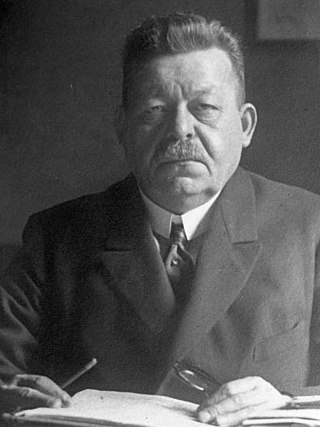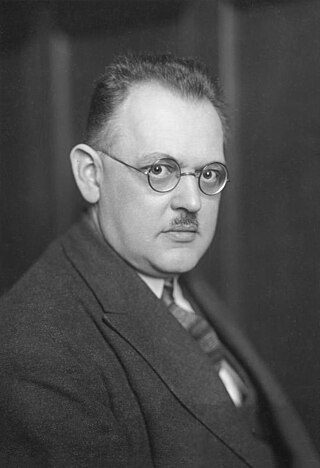Related Research Articles

The Ruhr, also referred to as the Ruhr area, sometimes Ruhr district, Ruhr region, or Ruhr valley, is a polycentric urban area in North Rhine-Westphalia, Germany. With a population density of 2,800/km2 and a population of over 5 million (2017), it is the largest urban area in Germany. It consists of several large cities bordered by the rivers Ruhr to the south, Rhine to the west, and Lippe to the north. In the southwest it borders the Bergisches Land. It is considered part of the larger Rhine-Ruhr metropolitan region of more than 10 million people, which is the third largest in Western Europe, behind only London and Paris.

The Kapp Putsch, also known as the Kapp–Lüttwitz Putsch, was an attempted coup against the German national government in Berlin on 13 March 1920. Named after its leaders Wolfgang Kapp and Walther von Lüttwitz, its goal was to undo the German Revolution of 1918–1919, overthrow the Weimar Republic, and establish an autocratic government in its place. It was supported by parts of the Reichswehr, as well as nationalist and monarchist factions.

The Ruhr Red Army was an army of between 50,000 and 80,000 left-wing workers who conducted what was known as the Ruhr Uprising (Ruhraufstand), in the Weimar Republic. It was the largest armed workers' uprising in the nation's history, and ran from 13 March to 2 April, 1920, in Germany's most important industrial area. The workers were reacting to the Kapp Putsch, an effort by right-wing forces in March 1920 to overthrow the elected government.

Friedrich Ebert was a German politician of the Social Democratic Party of Germany (SPD) and the first president of Germany from 1919 until his death in office in 1925.

The German Revolution of 1918–1919 or November Revolution took place in Germany at the end of the First World War. It began with the downfall of the German Empire and eventually resulted in the establishment of the Weimar Republic. The revolutionary period lasted from November 1918 until the adoption of the Weimar Constitution in August 1919. Among the factors leading to the revolution were the extreme burdens suffered by the German population during the four years of war, the economic and psychological impacts of the German Empire's defeat by the Allies, and growing social tensions between the general population and the aristocratic and bourgeois elite.

Gustav Noske was a German politician of the Social Democratic Party (SPD). He served as the first Minister of Defence (Reichswehrminister) of the Weimar Republic between 1919 and 1920. Noske was known to use army and paramilitary forces to suppress the socialist/communist uprisings of 1919.

The Communist Workers' Party of Germany was an anti-parliamentarian and left communist party that was active in Germany during the time of the Weimar Republic. It was founded in April 1920 in Heidelberg as a split from the Communist Party of Germany (KPD). Originally the party remained a "sympathising member of Communist International." In 1922 the KAPD split into two factions, both of whom kept the name but are referred to as the KAPD Essen Faction and the KAPD Berlin Faction.
The Ebert–Groener pact, sometimes called the Ebert-Groener deal, was an agreement between the Social Democrat Friedrich Ebert, at the time the Chancellor of Germany, and Wilhelm Groener, Quartermaster General of the German Army, on November 10, 1918. This occurred on the day after the German Revolution had brought Ebert to power.

Paul Levi was a German communist and social democratic political leader. He was the head of the Communist Party of Germany following the assassination of Rosa Luxemburg and Karl Liebknecht in 1919. After being expelled for publicly criticising Communist Party tactics during the March Action, he formed the Communist Working Organisation which in 1922 merged with the Independent Social Democratic Party. This party, in turn, merged with the Social Democratic Party a few months later and Levi became one of the leaders of its left wing.

The Free State of Prussia was one of the constituent states of Germany from 1918 to 1947. The successor to the Kingdom of Prussia after the defeat of the German Empire in World War I, it continued to be the dominant state in Germany during the Weimar Republic, as it had been during the empire, even though most of Germany's post-war territorial losses in Europe had come from its lands. It was home to the federal capital Berlin and had 62% of Germany's territory and 61% of its population. Prussia changed from the authoritarian state it had been in the past and became a parliamentary democracy under its 1920 constitution. During the Weimar period it was governed almost entirely by pro-democratic parties and proved more politically stable than the Republic itself. With only brief interruptions, the Social Democratic Party (SPD) provided the Minister President. Its Ministers of the Interior, also from the SPD, pushed republican reform of the administration and police, with the result that Prussia was considered a bulwark of democracy within the Weimar Republic.

Jan Appel was a German revolutionary who participated in the German Revolution of 1918. He became a prominent Left Communist activist and theorist.

Carl Wilhelm Severing was a German union organizer and Social Democratic politician during the German Empire, Weimar Republic and the early post-World War II years in West Germany. He served as a Reichstag member and as interior minister in both Prussia and at the Reich level where he fought against the rise of extremism on both the left and the right. He remained in Germany during the Third Reich but had only minimal influence on reshaping the Social Democratic Party after World War II.

The Ruhr uprising or March uprising (Märzaufstand) was a left-wing workers' revolt in the Ruhr region of Germany in March 1920. It initially took place in support of the call for a general strike issued by the Social Democrat members of the German government, the unions, and other parties in response to the right-wing Kapp Putsch of 13 March 1920.
The Freikorps Lichtschlag was a paramilitary unit in Germany that was established on 14 December 1918 just after the end of World War I.
During the First World War (1914–1918), the Revolutionary Stewards were shop stewards who were independent from the official unions and freely chosen by workers in various German industries. They rejected the war policies of the German Empire and the support which parliamentary representatives of the Social Democratic Party (SPD) gave to these policies. They also played a role during the German Revolution of 1918–19.

Max Hoelz was a German Communist, most known for his role as a 'Communist Bandit' in the Vogtland region.

The first Müller cabinet, headed by Chancellor Hermann Müller of the Social Democratic Party of Germany (SPD), was the third democratically elected government of Germany and the second in office after the Weimar Constitution came into force in August 1919. The cabinet was based on the same three centre-left parties as the preceding Bauer cabinet: the SPD, Centre Party and German Democratic Party (DDP), a grouping known as the Weimar Coalition. It was formed on 27 March 1920 after the government of Gustav Bauer (SPD) resigned as a result of the unsuccessful Kapp Putsch, which it was seen as having handled badly.

The Fehrenbach cabinet, headed by Chancellor Constantin Fehrenbach of the Centre Party, was the fourth democratically elected government of the Weimar Republic. It took office on 25 June 1920 when it replaced the first cabinet of Hermann Müller, which had resigned due to the poor showing of the coalition parties in the June 1920 elections to the new Reichstag. The 1920 Reichstag replaced the Weimar National Assembly, which had served as Germany's interim parliament and written and approved the Weimar Constitution.

The Bremen Council Republic, also referred to in English as the Bremen Soviet Republic, was an unrecognised revolutionary state in Germany formed in the immediate aftermath of the First World War. Although not formally declared until 10 January 1919, the regime it represented presided in the industrial-port city of Bremen from 14 November 1918 until its suppression on 2 February 1919 by army and irregular forces engaged by the government of the new German Republic in Berlin.
The Soviet Republic of Saxony is the name that is sometimes used to refer to a short-lived, unrecognized soviet state that was established in the former Kingdom of Saxony following the collapse of the German Empire at the end of World War I.
References
- ↑ Childs, David (2014-12-17). Germany in the Twentieth Century (RLE: German Politics). Routledge. p. 29. ISBN 978-1-317-54228-5.
- ↑ Lane, A. T. (1995). Biographical Dictionary of European Labor Leaders. Greenwood Publishing Group. p. 880. ISBN 978-0-313-29900-1.